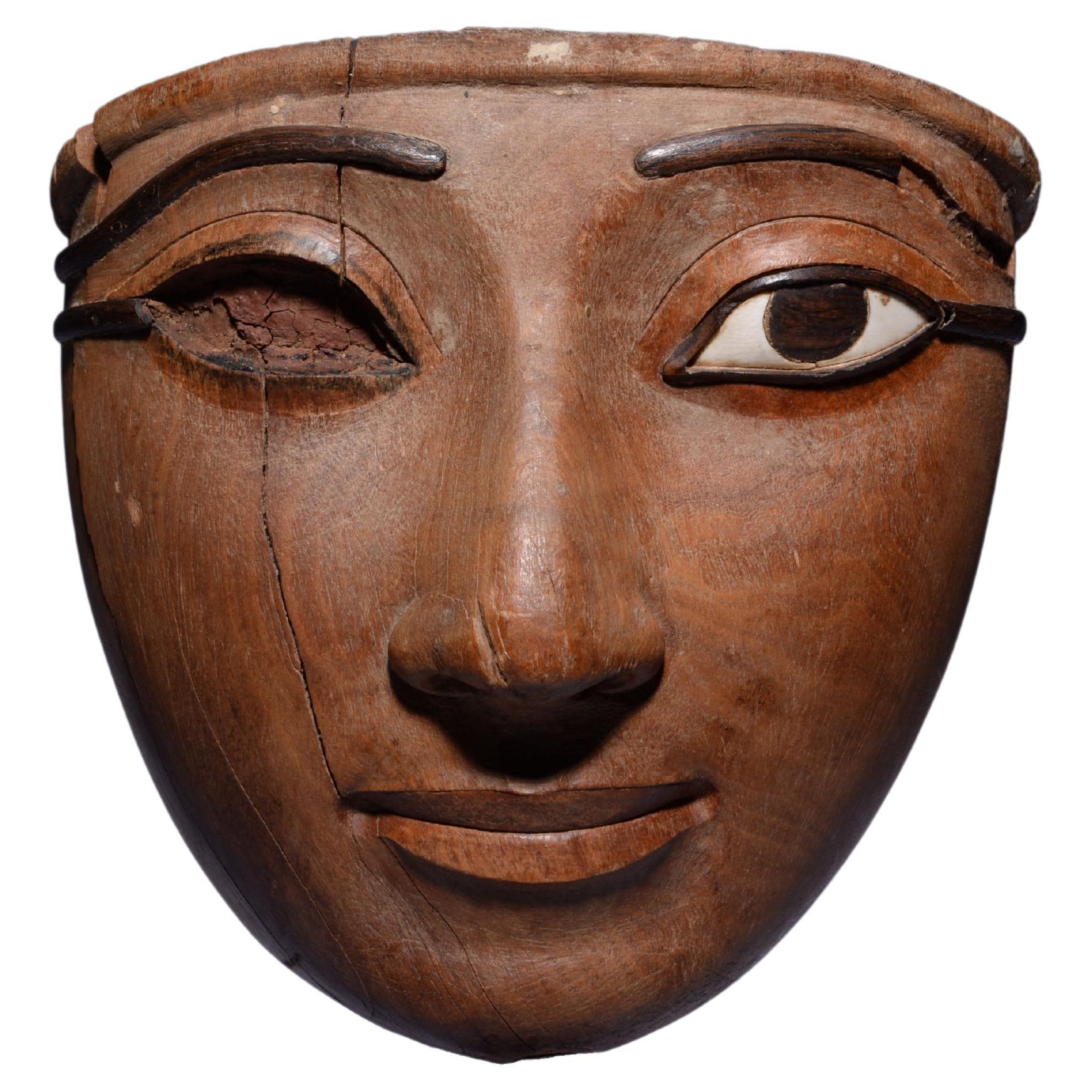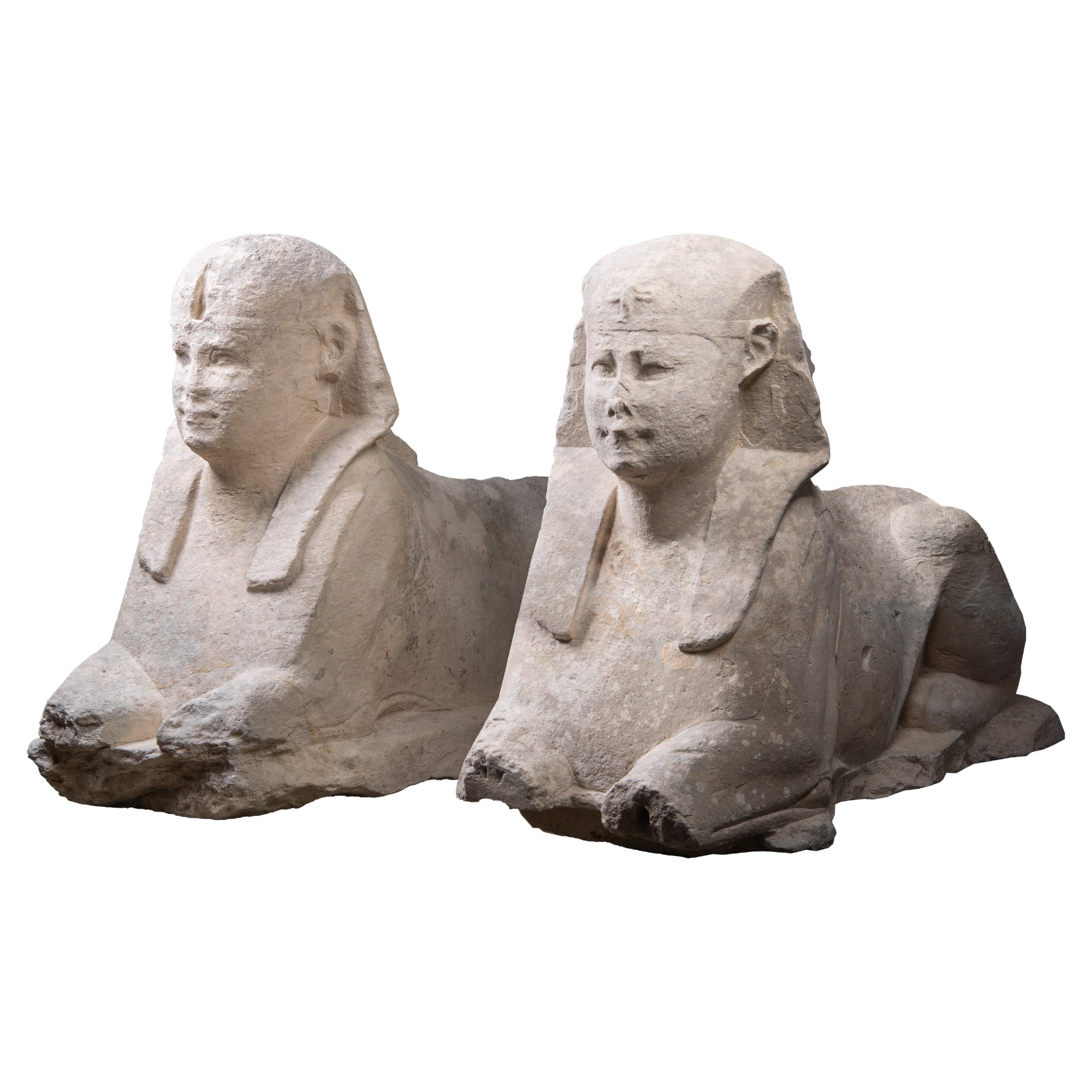Items Similar to Ancient Egyptian Mask, 900-600 BCE
Want more images or videos?
Request additional images or videos from the seller
1 of 6
Ancient Egyptian Mask, 900-600 BCE
About the Item
An ancient burial mask that was created to adorn a sarcophagus, 26th Dynasty, Minia, Mid-Upper Nile, circa 900-600BCE, from the collection of Joanna Barnes and Jack Warner, (Warner Bros.) now mounted on a display stand.
- Dimensions:Height: 15.5 in (39.37 cm)Width: 10 in (25.4 cm)Depth: 4 in (10.16 cm)
- Style:Egyptian (Of the Period)
- Materials and Techniques:
- Place of Origin:
- Period:
- Date of Manufacture:900-600 BCE
- Condition:Wear consistent with age and use. As found, mounted on custom stand.
- Seller Location:Doylestown, PA
- Reference Number:1stDibs: LU837035140912
About the Seller
4.9
Vetted Seller
These experienced sellers undergo a comprehensive evaluation by our team of in-house experts.
Established in 2004
1stDibs seller since 2007
462 sales on 1stDibs
Typical response time: 8 hours
- ShippingRetrieving quote...Ships From: Clinton, CT
- Return PolicyThis item cannot be returned.
More From This SellerView All
- Phyllis Morris Bronze Cat SculptureLocated in Doylestown, PAA large patinated bronze statue of a jungle cat by designer Phyllis Morris.Category
20th Century Indian Archaistic Animal Sculptures
MaterialsBronze
- Pair of Classical Figurines, 18th CenturyLocated in Doylestown, PAA pair of classical style figurines in painted terra cotta, French late 18th century. From the personal collection of Pierre Moulin, author of French Cou...Category
Antique Late 18th Century French Louis XVI Figurative Sculptures
MaterialsTerracotta
- Important Terracotta Bust of "Marianne", French Revolution, 1794Located in Doylestown, PAA historically important and early terracotta bust of "Marianne" the French symbol of the French Revolution, by an unknown sculptor named "Gensoul", depicting the young woman in a draped robe with bow and her hair tied-up with a band. This depiction of Marianne is similar to that of the portrait done earlier by artist Jean-Michel Moreau...Category
Antique Late 18th Century French Neoclassical Figurative Sculptures
MaterialsTerracotta
- Balinese Carved Wood Statue of a WarriorLocated in Doylestown, PAA carved wood statue of a warrior in traditional clothing, late 19th century-early 20th century. Retains traces of its original painted finish.Category
Antique 19th Century Balinese Folk Art Sculptures and Carvings
MaterialsWood
- Balinese Carved Wood Statue of a Female DancerLocated in Doylestown, PAA carved wood statue of a female Balinese dancer in traditional clothing, late 19th century-early 20th century. Retains much of its original painted fi...Category
Antique 19th Century Balinese Folk Art Sculptures and Carvings
MaterialsWood
- Figural Group of Fauns in a Naturalistic Setting, 19th Century FrenchLocated in Doylestown, PAA charming figural group of Fauns sitting above a waterfall, in cast stucco with terracotta painted finish, all on a custom wood base. Mid 19th Century. Base bears an old label from ...Category
Antique Mid-19th Century French Rococo Figurative Sculptures
MaterialsStucco
You May Also Like
- Exceptional Egyptian Sarcophagus MaskLocated in London, GBExceptionally Fine Wooden Sarcophagus Mask Third Intermediate Period, 21st Dynasty, circa 1069-945 BC. Acacia wood, rosewood, hippopotamus ivory Masterfully carved from a single piece of fine-grained hardwood, the present mask is characteristic of the most exquisite funerary art made during the 21st Dynasty, and was probably commissioned for a particularly high-ranking individual. The oval face displays a gently smiling mouth with full, outlined lips, furrows at the corners and a bow-shaped philtrum. The straight nose with rounded nostrils, the cheeks full and fleshy and the large, almond shaped eyes with heavy lids and tapering cosmetic lines, set below long, sweeping eyebrows. Social collapse across the Mediterranean in the Late Bronze Age meant that the 21st Dynasty in Egypt was a period of great turmoil. Trade routes were disrupted, governments collapsed, and mass migration occurred. Economic scarcity meant that traditional funerary practices in Egypt were also affected, with a lack of material and financial resources leading to the reuse of preexisting material. As a result, during the 21st Dynasty, 19th and 20th Dynasty coffins changed ownership rapidly and were heavily recycled for new purposes. Tombs were also unmarked allowing them to be shared by many people. These new practices brought forth a shift in the understanding of funerary paraphernalia. No longer important objects owned forever by the deceased, they were now simply seen as short-term transformative devices, whose symbolic and ritualistic meaning could be appropriated for others. However, paradoxically, the art of coffin-making also reached new heights during this period, and many of the richly dec- orated “yellow” coffins, characteristic of the 21st Dynasty, are remarkable works of art in their own right. Indeed, knowing that coffins were being reused throughout Egypt, the Egyptian élite set themself apart by commissioning lavish sarcophagi decorated with the images and texts meant to help guide them to the afterlife, and which would otherwise have adorned the tomb walls. As coffins were the chief funerary element which now identified the dead and allowed them a physical presence in the world of the living, their quality and appearance were of the utmost importance. The traditional coffin ensemble was made of three parts: a wooden mummy cover, which laid directly atop the mummy, an inner coffin, and an outer coffin, both made of a lid and case. Additional decorative elements, such as masks, were carved out separately and later glued or pegged to the lids. After the completion of the painted decoration, the sarcophagus was covered in a varnish to give it its yellow colour. Gilding was sometimes used for the coffins of the high priests’ families, notably on parts representing naked skin, such as the face mask. However, some of the élite tactically avoided gilding altogether as to ensure that their coffin would not be looted. When manufacturing the inner and outer coffins, particular attention was paid to the woodwork. Displaying the skill of the carpenter, this type of funerary art has largely remained unparalleled throughout Egyptian history. The principal wood used to craft the present mask is Acacia nilotica. The evergreen Egyptian acacia was considered sacred and said to be the tree of life, the birthplace of the god Horus, as well as symbolic of Osiris, the god of the dead and resurrection. The modelling of the face in the wood is superb, but the inlays also help mark this mask out as exceptional. Inlaid eyes and eyebrows were extremely rare and reserved to the finest and most expensive coffins. Traditionally, eyes were made of calcite, obsidian, or quartz, and eyebrows of coloured glass paste or bronze. Here, the pupils, eyebrows, and cosmetic lines are inlaid with Dalbergia melanoxylon, a rare type of wood which belongs to the rosewood genus. In antiquity, however, it was known as Ebony of the Pharaohs, from the Egyptian word “hbny”, meaning dark timber, because of its black, lustrous appearance. An extremely dense and hard wood requiring significant skill to work with, ebony was a luxury material highly coveted by the pharaohs themselves, to make furniture, decorative and funerary objects. The wood was imported with great effort from the southern Land of Punt, most likely modern Sudan, Ethiopia, Djibouti, and Eritrea, alongside other luxury goods such as gold and ivory. A magnificent ebony throne, recovered in the tomb of King Tutankhamun, illustrates the incredible aesthetic potential of this material and why it was so highly valued by Egyptian royalty. Only élite members of Egyptian society could have afford- ed Ebony of the Pharaoh inlays for their funerary mask. The sclerae on the present piece were once both inlaid with hippopotamus ivory. Whiter than elephant ivory, this type of ivory is also denser, and more difficult to carve. The use of this luxury material, reputed for its gleaming appearance, enhances the lifelikeness of the eyes. For the Egyptians, hippopotamus ivory was imbued with magic powers. The hippopotamus was indeed both feared and venerated due to its aggressive behaviour. Whilst the male hippopotamus was associated with danger and chaos, the female was benevolent and invoked for protection, especially of the house and of mothers and their children, through the hippopotamus goddess Tawaret. Thus, not only was hippopotamus ivory used as an inlay and to make practical objects, such as combs and clappers, but it was also used to make talismans like apotropaic wands or knives. Made during a time of scarcity where few could afford made-to-order coffins, the present mask could have only belonged to one of the highest-ranking individuals in society. Undoubtedly one of the finest Egyptian coffin...Category
Antique 15th Century and Earlier Egyptian Egyptian Figurative Sculptures
MaterialsFruitwood, Hardwood
- Ancient Egyptian Monumental Temple SphinxesLocated in London, GBA pair of monumental limestone sphinxes of Pharaoh Nectanebo I, from the processional avenue of the Serapeum of Memphis, 30th Dynasty, circa 379 - 360 BC. The sphinxes of the Serapeum have captivated travellers since Roman times. However, despite their significance, they are conspicuously absent from the collections of most major museums. Indeed, their existence in private hands is so improbable, and their imitations so numerous, that the present sphinxes were assumed to be modern copies throughout their recent ownership history. Finally recognised and conserved after an extraordinary chance discovery at a garden furniture sale...Category
Antique 15th Century and Earlier Egyptian Egyptian Figurative Sculptures
MaterialsLimestone
- Ancient Egyptian Style Marble Hand-Carved Bust, 20th CenturyLocated in Southall, GBExquisite Hand-Carved Marble Bust: Inspired by the 'Magical Statue' from Thorvaldsen Museum, Copenhagen. Elevate your space with this extraordinary marble bust, a testament to the m...Category
Late 20th Century European Egyptian Busts
MaterialsMarble
- Grand Tour Ancient Egyptian Style Carved Soapstone Figure of HorusLocated in Stamford, CTGrand Tour carving of Horus, ancient Egyptian god in the form of a falcon. Quite possibly much earlier in date, that is beyond my expertise. From a collection that did have ancient p...Category
Antique Late 19th Century Egyptian Egyptian Animal Sculptures
MaterialsSoapstone
- Bronze Figure After the Ancient Egyptian FragmentLocated in New York, NYBronze figure after the ancient Egyptian fragment.Category
20th Century Unknown Figurative Sculptures
MaterialsBronze
- Ancient Roman Theathre Mask Myra No:1 SculptureBy LAGULocated in İSTANBUL, TRIt was found in the ancient city of Myra in Antalya, Turkey. It was used as a mask in theaters during the Roman period. The city of Myra, one of the six most important cities that w...Category
2010s Turkish Classical Greek Busts
MaterialsStatuary Marble





